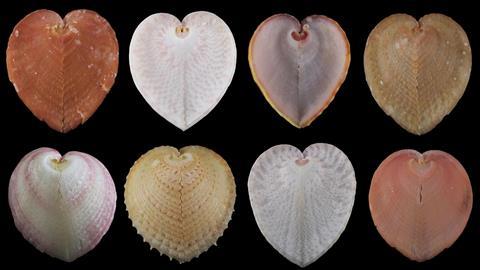Several molluscs have developed benificial relationships with symbiotic, photosynthetic algae. Heart cockles boast advanced biophotonic structures in their shells that operate like optic fiber cables to catch and transmit the incoming sunlight.
Bivalves, including the heart cockles (Corulum cardissa) featured here as well as the much larger —what’s in a name — giant clams, have evolved symbiotic relationships with photosynthetic algae. To supply their resident algae with sunlight, giant clams simply open their shells on a regular basis, but Dakota McCoy (University of Chicago) and colleagues discovered that heart cockles have developed a much more refined technique.

The rigid and opaque shells of C. cardissa contain small transparent structures that act as ‘windows’. These structures consist of aragonite, a crystalline form of calcium carbonate. Through these windows, the incoming light is projected onto ‘microlenses’ on the inside of the shells that filter out harmful uv-radiation and subsequently condense and transmit the light deeper into the cockles’ tissue. Because of these combined actions, these biophotonic structures function like fiber optic cable bundles, McCoy and team write in Nature Communications. According to them, the heart cockles’ biophotonic adaptations offer new inspiration for the development of (bio)materials capable of transmitting light.
Dakota McCoy, et al., Heart cockle shells transmit sunlight to photosymbiotic algae using bundled fiber optic cables and condensing lenses, Nature Communications (2024), doi:10.1038/s41467-024-53110-x













Nog geen opmerkingen